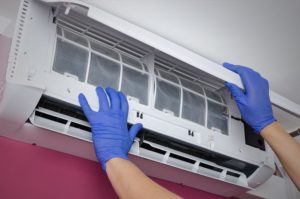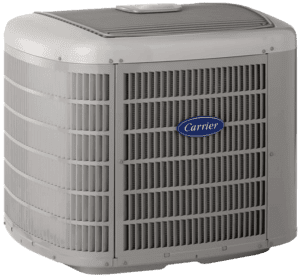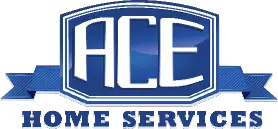The weather in Phoenix can be brutal. With an average overnight temperature of 43 degrees in January and an average daytime temperature of 104 degrees in July, “extreme temperature” is an understatement! Add the wind and dust and you couldn’t have a more inhospitable climate for your home or business AC unit.
Carrier HVAC units are made to stand up to the extreme weather in Phoenix. They bring quiet, energy-efficient comfort to millions of people every day. Carrier air conditioner units provide innovative, efficient solutions that are constructed to be reliable and easy to maintain with components designed to meet any need.
What Types of Carrier A/C Units are Out There?
Carrier heating and cooling units consist of multiple components and may include a furnace, evaporator coil, air conditioner or fan coil and a heat pump system. Carrier makes several different types of air conditioners to meet the needs of homeowners. These include:
Spilt systems
A split system resides both inside and outside your home, with the exterior component removing heat and the interior components providing conditioned air.
Hybrid split heat system
Split system air conditioners consists of both a gas furnace and an electric heat pump. It gauges the outside temperature and then chooses the most cost-effective fuel.

Ductless split system
This system is designed to heat or cool areas that do not have ductwork, like an addition, exercise room, garage or anyplace else a traditional duct system may not work.
Packaged systems
Some homes lack the space for a true split system. Packaged cooling systems combine components into a single unit that is placed outside your home.
Geothermal heat pump systems
Geothermal heat pumps access the consistent temperatures deep in the Earth to heat or cool your home. They are among the most energy-efficient, environmentally friendly systems available today.
No matter what your heating and cooling needs, Carrier produces systems that can meet them, quietly, efficiently and cost effectively.
How Does Air Conditioning Work?
How air conditioning works is to reduce the ambient temperature of a room using a simple scientific principle along with state-of-the-art technology. Much like your home refrigerator, AC units use refrigeration to chill indoor air using a simple law of physics: When a liquid converts to a gas using a process called phase conversion, it absorbs heat.
Air conditioners use a special chemical compound to evaporate and condense repeatedly in a closed system of coils. AC units use fans to move warm interior air over cold liquid-filled coils. The air is delivered through a system of ducts that bring warm air to the coils and then, using a fan, distribute it throughout your home.
When the warm air is introduced, the refrigerant inside the coils absorbs the heat as it changes from a liquid to a gas. A compressor places the gas under high pressure, which converts it back to a liquid. This creates heat that is then vented outdoors by a second set of coils, called condenser coils, and a second fan. The process then repeats.
An air conditioning unit contains compressors and fans, as well as a thermostat, to regulate the air temperature and a filtration system to remove airborne particles. Air conditioners also remove moisture from the air acting as dehumidifiers. By reducing the temperature of the air, you remove a portion of the moisture. That’s why your cooling system discharges water on a hot day.
See also: How much does an air conditioner compressor cost to replace?
A split system consists of two sets of compressors, condensers, coils and fans. The unit that controls the release of heat is placed outside of your home. This unit releases the heat, converts the gas back to a liquid and delivers it to the indoor unit. The cooling unit is placed in your home and distributes cold air throughout the house, then passes the heated gas outdoors where it is released. The process repeats until the thermostat shuts off the unit when the requested indoor temperature is achieved.
Common Problems with A/C Units
Your AC system is made up of several parts, including the condenser coil, motor, fans, tubes and circuit boards. Failure can happen suddenly or slowly over a long period. That’s why it’s important to keep your system properly maintained.
Here are some common problems you may encounter:
Dirty components
Even with regular maintenance, your unit may need occasional repairs. Because most of the unit is placed outdoors where it is subject to weather, it’s not unusual for the condenser to attract debris or have grass or brush grow near the unit. This can prevent proper operation.
Leaks
Another common problem are refrigerant leaks within the system. Faulty tubes and seals sometimes happen and can cause the condenser to fail. Tubes can become brittle over time and rupture.
Blockage
Debris can accumulate within the AC unit. This can lead to blockages, causing the condenser to fail. While debris can be external, metal particles can also flake off of the condenser as a result of age.
Bad capacitor, bad condenser relay switch, faulty control board
Today’s modern systems consist of many computerized components. Often a bad capacitor or switch can prevent the fan from operating properly and cause inefficient operation of your system. If critical parts like the fan, motor or coil don’t operate properly it can compromise the component or your entire system.
Damaged coil or burnt motor
These are severe problems that can compromise your entire system, leading to replacement. Often these types of failures take place over time and are not sudden. As a result, your unit will use more energy and heat and cool less effectively. Again, proper regular maintenance can often detect and address these issues before they become critical.
Carrier Condenser Not Turning On: Repair or Replace?

One question often posed to homeowners is: do you repair or replace your air conditioner? Often with regular maintenance you can avoid major problems. The Phoenix weather can be especially hard on your AC unit so maintenance should be performed regularly. Problems like a dirty condenser are easy to remedy by keeping the area around your outside unit clean and debris-free. Other problems like a bad run capacitor, condenser relay switch or a faulty control board are relatively inexpensive and easy to repair.
Some problems, however, can be costly. Again, regular maintenance and inspection can often identify potential problems before they become critical. Failure of the motor can often mean replacement. Make sure that the replacement motor is identical or meets the manufacturer’s specifications exactly. Introducing a motor with different specs can be disastrous and result in a complete system failure.
The same is true with the condenser coil. The first step is to clean the coil. If that doesn’t fix the problem, replacement may be necessary. Because this repair requires extensive labor and time, it can be an expensive fix. If your coil is out of warranty, it may be best to consider replacing the entire AC unit.
When considering repair or replacement, consider the age of the unit. Advances in technology have made today’s systems much more efficient, quieter, more environmentally friendly and cheaper to operate. If your system is experiencing fluid leaks or a major blockage and it’s 10 years old or older, replacing the entire system is a viable option. Thanks to advances in efficiency, you can often recoup your investment through lower operating costs in a relatively short period of time.
General Costs to Replace or Fix Carrier AC Units
As a general rule, expect to pay between $200 and $600 for most repairs. Some can cost as little as $100 for basic maintenance or a quick part swap. Complex jobs and multiple parts can cost up to $1,000 or more.
Major issues like leaks or a blockage can cost as much as $1,750 to repair. At this point, if your system is older, you may want to consider a full replacement as it may make better financial sense.
The best option is to sign up with a professional HVAC contractor for regularly scheduled maintenance. They will change your filters, visually inspect your system and can often identify and remedy problems early, saving your money on repairs. No matter how extensive or minimal the work, make sure any company you choose offers at least a one-year warranty on parts and labor.
Your cooling unit is a big investment. Keep it properly maintained and you’ll experience many years of reliable, efficient service. If your system is 10 years old or older, consider replacing your aging system with a new energy efficient model. You’ll recoup your investment in a few short years through lower energy costs, and your home will stay comfortable while having less impact on the environment!
Get Professional Help for Your Carrier Air Conditioning System Today
If you live in the greater Phoenix area, contact the experts at ACE Home Services by calling at (602) 428-3341 . They are a licensed Carrier dealer and offer great prices on new Carrier AC systems and carrier air conditioner maintenance. They also offer Carrier AC service plans in Phoenix that can keep your system running efficiently all year long!



